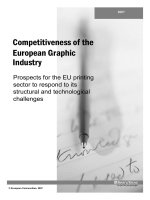PROSPECTS FOR THE EU PRINTING SECTOR TO RESPOND TO ITS STRUCTURAL AND TECHNOLOGICA, CHALLENGES pptx
Bạn đang xem bản rút gọn của tài liệu. Xem và tải ngay bản đầy đủ của tài liệu tại đây (1.34 MB, 148 trang )
Competitiveness of the
European Graphic
Industry
Prospects for the EU printing
sector to respond to its
structural and technological
challenges
2007
©EuropeanCommunities, 2007
2
This report has been producedby E&Y as part of the projectfinancedby the EuropeanCommission
(Enterprise and IndustryDirectorate-General). Itscontent thereforerepresentsE&Y’s ownviewson the
subjectmatter.
The viewsexpressedin thisreport, as wellas the information includedin it, do not necessarilyreflectthe
opinion or position of the EuropeanCommission and in no waycommit the institution.
For furtherinformation, contact
EuropeanCommission
Enterprise and IndustryDirectorate-General
Unit G4
B-1049 Brussels
Fax: (32-2) 29 69 638
E-mail:
©European Communities, 2007
Reproduction is authorized provided the source is acknowledged
3
Contents
Summary of methodology and scope of the study
Proposition for an action plan dedicated to the European
Printing Industry
Structure of the plan
Detail of the actions
Summary of the analysis of the European Printing Industry
Printers’point of view
Strengths, Weaknesses, Opportunities, Threats analysis
5 Structural challenges for the European printing industry
Appendix
General context
Origin of pulp and paper
Comparison of financial ratios
Detailed analysis of the European printing industry and
impact from international competition
Context
Industry & Organisation
Market, Products, Consumers
Technological development
Printing industry in China
International exchanges and relocation of the production areas
1
3
4
5
6
4
15
31
44
127
A day with Mr Print
2
8
Part 1 –
Summary of
our methodology
and scope of the
study
5
Objectives of the study
• Collect and organise the main documents dealing with the European printing
industry and its environment.
• Identify the impacts on the sector.
• Set up a forecasting diagnosis describing the possible future ofthe sector.
• Determine the economic and international challenges for the sector.
• Identify and explain the structural and technological challengesof the sector.
• Identify the technological opportunities for the European printing industry to
evolve and improve its competitiveness.
Phase 2
Assessment
of impacts
Phase 2
Assessment
of impacts
Phase 1
Diagnosis
Phase 1
Diagnosis
Phase 3
Strategic plan
Phase 3
Strategic plan
• Measure and evaluate threats and opportunities.
• Measure and evaluate the foreign structural changes that are likely to threaten
the European printing sector.
• Measure and evaluate consequences resulting from possible technological
improvements.
• Identify development of strategic priorities
• Identify efficient innovation levers for the sector.
6
Outline of our approach (1/2)
The study lasted 8 months and was monitored by a steering committee formed by the
European Commission.
This steering committee met three times during the course of thestudy in order to validate the
work in progress for each of the following phases:
1. Diagnosis
2. Evaluation of impacts
3. Setting-up of a strategic plan
European Commission would like to thank all the members of the steering committee for their
participation in the production of the content of this report, including the following :
• Ms Beatrice Klose, Intergraf
• Ms Anne-Marie De Noose, Intergraf
• Ms Martina Flink, Intergraf
• MrNicola Konstantinou, UNI-EuropaGraphical
• MrDavid Mahon, FAEP -European Federation of Magazine Publishers
• Ms Sophia Chrysopoulou, EPC/European Publishers Council -Europe
Analytica
• MrRick Stunt, ENPA Newsprint
• Ms Helene Juhola, ENPA Federation of the Finnish Media Industry
• MrIsidoreLeiser, Stratus Packaging
• MrStephan Schumacher, Bertelsmann AG
7
The main actions launched during this study were allocated to the diagnosis phase:
• A workgroup with the British Federation
• Four workgroups in four European Countries :
• A workgroup bringing together French Printers in Paris
• A workgroup bringing together Italian Printers in Milan
• A workgroup bringing together German Printers in Frankfurt
• A workgroup bringing together British Printers in London
• Interviews with stakeholders of the graphic industry, mainly clients of printers, in order to
gain a deeper understanding of the industry’s main market stakes
The evaluation of impacts phase was composed of three milestones:
• A technological seminar led by the EFPG (French Engineering School dedicated to the
paper and graphics industries), bringing together academics, suppliers and technological
experts in the graphics industry. This seminar was fruitful in that it identified the main impacts
on the competitiveness of the European Graphics Industry that could be brought about by
technological improvements expected in the future.
• About 30 interviews with European experts
• A quantitative survey, the aim of which was to provide statistics relating to the main impacts
identified in the previous phase. The survey consisted in the setting-up of an online
questionnaire circulated to a list of printers provided by national federations. Nevertheless the
survey did not obtain the adequate number of responses enabling the mathematically reliable
exploitation of figures for statistical use. In agreement with the steering committee, the results
of the survey have not been mentioned in the report hereafter.
The last phase dealt with a proposition for a strategic plan to support the European graphics
Industry. A strategic seminar teaming the steering committee and representatives of national
federations took place in Brussels on 2 May in order to submit and validate the plan of action
developed. The different points of view of those present concerning the diagnosis were also
collected during the seminar.
The scope of the study was defined at the first steering committee meeting:
• The study will focus on activities listed under the NACE code 22.2.
• Due to conflict between diverse data sources, EurostatDatabase has been taken as a source
of reference, whenever information is available.
• Accounting for around 80% of the whole European Graphics Industry’s turnover, number of
employees and number of companies, the following countries have been considered as
representative of the European sector: Germany, the United Kingdom, France, Italy, Spain,
Belgium and the Netherlands. Most of the qualitative or quantitative analyses have focused
on this country panel.
• These countries will represent EU27, but sometimes EU15 wheneverthe distinction is
pertinent.
• The findings and conclusion of the study are particularly relevant for sheetfeld offset printing,
which is currently the widest used printing process, and partially for weboffset, rotogravure,
digital printing and packaging printing.
8
Part 2 –A day with
MrPrint :
a short story illustrating the daily and
structural problems faced by a
European SME manager …
9
It is early one chilly morning and Marc Print shivers as he pushes open
the door into the reception area at his printing business. He has got out of
bed on the wrong side this morning, and the very idea of an appointment
with his banker does not really thrill him.
«Les EtsPrinteur», Marc’s printing company, is located in a bleak
industrial estate. The workers didn’t really appreciate the move five years
ago, to a location further away from their homes, and with public transport
always either on strike or running late. Marc had warned them that they
would have to travel by car anyway due to their hours and shifts. So they
all moved with the company –what other work would they have found
nearby?
Marc walks to his office carrying his briefcase. He first goes to the
planning department. At this hour, there is hardly anyone there except for
people working in production and planning.
Standing in front of the wide blackboard on which the planning has been
drawn up, he listens to his young planning manager who is reporting on
events which occurred during the previous night.
“Rotonumber 3 broke down at 20hrs yesterday. The head foreman tried
to solve the problem himself but in the end he had to to call the
maintenance team who diagnosed that the strain controller was deficient.
Since all these machines are stuffed with electronics, they had to wait
until the next morning for the electro mechanical technician to arrive.
Since then everything has been fine, the press is running at 40000 rpm.
We still have delays on remaining jobs, we won’t be able to do the short
prints for the county council, you know the monthly edition. I’ll have to put
the print for Legrandfirst. It will be stapled on the press, and the job has
to be delivered today”
It has always been the same story, the same thing, ever since Marc has
worked in the company created by his father 40 years ago. Of course the
presses are different from in the past, even the preparation of the presses
has changed from when the operators used to cut the films with stanley
knives to insolate them. Now the company is using CTP (computer to
plate) in pre-press. However, technical problems still occur regularly in
the production process. There have always been dissatisfied customers
about delays, although we try the best we can to satisfy them. We have to
pamper them otherwise they go elsewhere. If they knew how hard and
complicated it is being a printer…
Before leaving the planning department, Marc takes a look at thework
load. There is just enough to fill the next two or three weeks, not more.
The salesmen will need to be shaken up a little bit; just as well he’s
seeing them on Monday for a business meeting.
Going back to his office, he finds that his assistant has just arrived.
“Any appointments scheduled for this morning?”
“Yes, Marc. This morning, there is a meeting with the worker
representatives. I have put all the information you need in the file with the
agenda, and comments from Philippe. Then, this afternoon, you know …”
Of course he remembers, the bank…
10
Philippe, the staff manager, is a great person, devoted and highly
competent. He does not hesitate to reprimand or to say no, but he is
always ready to listen, and he is very humane. That counts, in asmall
company.
Marc goes into his office; he has to study the file for the meeting with the
trade union.
”It’s been two years since we’ve been given a rise. The break time could
be included in the working hours.”Of the three employees on the other
side of the table, Karineis the most virulent and the one who has been
with the company for the longest time.
Marc thinks for a few seconds. He had promised himself that he would
not give way at all. It is not possible, the company’s results are too poor.
He does not have to deal with the hardest trade representatives;he
knows some of his colleagues who do…
At the same time, he quite understands the workers. He has not been
able to maintain their purchasing power, and rises in wages havebeen
kept for the most deserving. The problem is, those who are claiming for a
wage rise are the operators, the ones who are already the most well paid.
And if he gives them what they’re asking, he will be forced to give
something to all the others, otherwise things will go badly, Karinehad
warned him.
He knows all the workers very well, the ones who have been with the
company for longest already worked for his father. In most cases, he also
knows their families whom he meets at Christmas celebrations.
“So what do you say?”Karinesays to Marc who gives a start, surprised
by her tone.
Karineworks in prepress (equipped with CTP and CAP). That has always
been the way of things –the union members often come from prepress
and maintenance. Well things don’t change.
The phone at the end of the table rings. Pierre answers it and passes it to
Marc: “Press no. 3 has broken down again”
Marc takes the phone. “Yes, just a minute, I’m coming, we’ve almost
finished.”
Marc speaks calmly to Karine, aware that everybody is watching him: “It’s
an emergency, we’re going to have to stop the meeting. But I have
understood your problems and claims. I propose that the break time
should indeed be reckoned as time, but as part of the modulation hours,
not the regular working time. Philippe and I will make you a proposal for
the next meeting. Is that OK?”
He stands up, looking round at everyone for their tacit consent.Karine
nods in answer; they have reached an understanding.
11
It wasn’t actually what the union members requested. But this way, the
company will grant additional holidays to the workers, during slack times,
not when there is a full workload. Otherwise he would have been forced
to hire temporary workers or have people work overtime.
So, he has given way, but it will not affect the final accounts,and the
union can return to its troops and claim victory.
“I forgot to tell you, Marc, but this morning I called Legrand’spurchasing
department.”
A pause.
“And?”
Marc and Antonio are having their second coffee, sitting at a small round
table, in the huge, noisy room at “la Brasseriedu Commerce”. Lunch is
often an opportunity for Marc to talk with the company’s executives, to
cheer them up in times of stress. This is not usually the case for Antonio,
the best salesman and the one generating and managing the portfolio
with the highest turnover. Antonio is still as enthusiastic as during his first
days with the company, which is maybe why he has this lasting and good
relationship with his customers and prospects. But this time, heseems to
be worrying about something.
“Yes, and?”he repeats.
Antonio sighs and continues.
“Don’t you remember the bid invitation which was sent last month? We
worked on a proposal for two days. There were about thirty references
with different versions. We had to make a proposal for all of them,
because Legrandthen only wanted to deal with one printer. So we had to
subcontract part of the production that we couldn’t do ourselves and we
made a global offer. Since the market is national, we had to include the
transport from all over the country.”
Antonio is obviously trying to gain time. Marc remembers all these
estimated costs very well, he had worked on the proposal himselfduring
the Easter weekend. Is he trying to tell me that we have lost the market?
Legrandis our second or third most important customer. It would be a
hard blow for the company if that’s the case. No, it’s not possible; we can
still try to negotiate. To think that we already reduced our prices by 5%
last year!
“Do you mean our offer hasn’t been accepted?”
“Not entirely. In fact, the decisions are no longer being made atnational
level. You know that Legrandis a subsidiary of an American group who
also owns stores in other European countries. Starting from thisyear, all
bid invitations are to be centralised in England. Today they areworking
with about ten printers; only three of them will remain at European level.
The competitive bidding has been cancelled. We will be consultedthree
or four months after the summer holidays. My purchaser, who I’ve known
for ten years now, won’t be part of the new organisation, he didn’t want to
work with the English purchasing team.”
12
“So you will have new negotiating partners. We cannot afford to lose this
market. We must be one of the three; it’s the opportunity to increase our
volumes considerably, isn’t it?”
Marc knows he will be playing double or quits. There is a chanceof being
among the happy three, just as there is a chance of being definitively
ruled out. The game is going to be tough and tight.
“I know, we’ll do our best. But you know…I don’t speak English,”Antonio
says.
Yes, Marc knows that very well, it’s becoming a real issue. Not only
because none of the salesmen speak English (Marc will deal with the
customer himself, it won’t be the first time), but above all because few of
the plant’s employees speak any foreign languages. Customers, and
mostly the major ones, want negotiating partners who speak their
language: a sales assistant, a manufacturer, or even somebody incharge
of production or a rotary press operator…
“If necessary, I’ll take over. Did you get any valuable information out of
your former purchaser?”
“Yes, they’ve decided to include various kinds of services in the
consultation. The proposal will be judged as much on the printing as on
those services. He told me about the archiving of files in the production
flow process and also last-minute changes on CAP, finished-product
stocking, routing services for their registered customers, and even
stocking/packaging of gifts, gifts they offer with their loyaltycard. All of
this with quality audits and performance indicators, you see what I mean?
We’ll be able to manage all this, but our people will need special training
for these services to meet their requirements.”
Antonio sighs.
Marc agrees with him. Printers are going to make more profits with
services rather than presses. Customers are ordering printed matter in
the same way as if they were buying electricity or telephone services –it’s
the quality of the service that counts.
“Thank goodness they haven’t opted for inverted auctions. There is
nothing better than a faked lottery.“
Eric sits before his boss. He has been working for the company for 15
years. From warehouseman, he went through the supply unit and isnow
a purchaser. He knows all the paper references inside out and hehas
already shown his purchasing talents when it comes to dealing ontariffs
and discounts.
“Marc, we have a problem. The paper for Legrand’sprint, you remember
the national 32 pages, we won’t be delivered today. The machine setting
is scheduled after tomorrow.”
“What’s their argument?”
“They’re out of stock.”
“Do we know why?”
Marc knows very well that a paper supplier cannot run out of paper in the
case of a standard reference such as this.
13
“He didn’t want to say. That they had computer problems, that they
underestimated their needs. I had heard that there were strikes in Finland
last month. But I don’t believe them, I think they had low stocks and they
preferred to deliver the paper to one or two of our colleagues without
warning us.”
“I’ll try to call them back, one never knows; in case it doesn’t work, do you
have an idea?”
Marc’s workers are used (mostly the management team) to making
proposals whenever there is a problem to be solved. This has given them
a sense of responsibility. They now show real creativity in the face of
adversity. His role is then to arbitrate and judge the financialimpacts of
the various choices he is being given. Or anticipate their impact on any
other of the company’s departments. Of course, he contributes his own
experience and expertise, but this way of managing enables him to
assess the maturity of his troops.
“We can try to get an emergency supply from another company. Their
depot can deliver 24 hours a day; the print will be delayed by the same
amount of time. I don’t know if it’ll work and we still won’t have the best
price”
“I’m not really keen on that solution. Our selling prices are already too
high and we’ll ruin the remaining margin we could have made. Is there
nothing left from last month’s printing?”
“Not that much, just enough for 20% of the printing. We could maybe use
a lower grammage, we have enough in stock.”
Marc reacts right away. “No way, we’re in negotiation with them now. If
they take a sample to control, things will get worse. You remember we
asked them two years ago to allow us to use a lighter paper justfor once.
They refused; it’s not mentioned in the specifications.”
It had to happen just when we’re dealing with Legrand, at a time when we
have to be irreproachable with them. Paper manufacturers have merged,
the market is now concentrated and our negotiating capacity has
decreased significantly. Marc does not gave enough levers to balance the
growing importance of the multinational manufacturing companies.He
tries to deal as well as he can with the three or four major suppliers in the
market.
“I have an idea. If Legrandhas priority, we’ll use the paper that ought to
be used for central merchandising printings, it’s the same amount of
paper. We’ll try to find a convincing explanation.”
Marc agrees with him. “You always find answers to all your problems…”
14
The banker is to arrive in a half hour. Marc is in his office, wondering if his
accountant gave him all the information on results and cash flow
predictions? Are the selling assumptions and margins realistic?
Marc would like to buy a new press, to replace the two oldest ones. They
can still run for another 10 or 20 years, if they are well maintained, but the
new press runs faster, and it will be equipped with the latest high tech
options. He will sell the two old presses to someone who specializes in
press refurbishment and will need them to sell either in Asia orLatin
America.
The new press will produce as much printing matter as the two older
ones. The shifts working on those two presses will be redeployedto night
shifts. Marc prefers to keep them, it is hard nowadays to find good
machine operators.
Marc has chosen his machine carefully. He remembers the numerous,
long meetings he had with his salesmen, in order to be sure thatthe
press would fulfil customer needs and requirements. The bank –which
was already the company’s bank in his father’s time -will lease the press
if Marc succeeds in being convincing on volumes and selling prices.
He knows that the banker will take advantage of the situation toask
questions on the business. The turnover had decreased slightly last year,
for the first time in the company’s existence, and the net result is barely
balanced. Marc will have to be persuasive to justify the purchase of a new
press. Can a banker understand the fact that investing could prevent the
company from going bankrupt even though the context does not seem to
be in favour of a new investment? His customers, although faithful to him
till now, will be looking to the competitors for lower prices. And how can
we make less expensive estimates while being unable to improve our
productivity? How can we improve productivity without investing in new
presses?
Marc knows that future of printing industry isn’t only led by productivity but
although by a thin management of the customer relationship. He’s got
some ideas dealing with services, delivery support, internalization of the
quality processes, shipping and so on but he’s convinced the future of the
printing industry is tied to its origin. Indeed, it appears thatprinters have
to become information providers, with some multimedia solutions and a
strong focus on the customer’s expectations. But what do Marc knows
about his customers? Nothing. because he’s often filtered by the
purchaser of printing matters whom didn’t know anything about printing
industry constraints.
Marc got a lot of ideas about the future of his company, If, as Kipling says!
But the banker isn’t a ‘if’man, is pragmatic and he will surely talk about
the future of the company. Marc does not have a successor, an heir to
whom he could have passed on the company. He feels responsible for
the continuity of the company, especially towards the workers. But he is
so involved in the daily management of the company that he does not
spend enough time examining the different possibilities. Will hebe forced
to sell the family business? To whom and how?
His assistant interrupts. “The banker has just arrived”
15
Part 3 –
Summary of the
analysis of the
European printing
industry
16
Part 3a –
The printers’point
of view
17
Diagnosis of the European printing industry
European printing industry is highly fragmented and more than 85% of the industrial
structure is composed by SMEsemploying less than 20 workers.
The printing market should be considered to be a European market. Most of the
major printers have, depending on their size, an export activity. Small enterprises
are also concerned, as they are confronted with foreign competitors who are active
in their markets. Globally this market is static and not really dynamic. Is there
enough room for expansion for all the players? What kind of future could there be for
small companies without significant structural changes? Are these companies too
numerous and destined to strive for survival? The industry appears to be too fragile,
too fragmented, to prevent the intensification of a restructuring process in most of
the European countries. This restructuring would have an impact mainly on SMEs.
Bearing in mind that a strong concentration process has already affected large
companies in the past, the future restructuring would have an impact on SMEs.
Newcomers in the market have increased the competition:
Brokers do not yet have a large market share but they influence market orientations
and impose new distribution margins and offer major clients new alternatives for
sourcing.
New significant providers from emerging countries (Eastern and Central Europe,
China) force printers to redefine their market position by integrating more services
and building a closer relationship with their clients: data basemanagement, on-
demand printing, personalisation of products and services, etc., could contribute to
consolidating customer links and givingaccess to attractive markets (protected in
that way from foreign competition).
Entrepreneurs and managers in medium-sized companies are still much involved in
the rationalisation of internal resources, resource-sharing and networking with other
players or trade activities in order to improve margins.
These ways of organisational innovation could generate financialresources allowing
the financing of development projects and acquisitions.
Most printers have the feeling that their business is structurally changing under the
influence of powerful drivers : printed documents vs. internet and new media,
economy of scale and global supply to satisfy some markets, industrial organisation
and investment strategy, etc.
The crucial restructuring necessary to reshape the industry and be able to face new
competition could require profound transformation and potentially significant
cutbacks in terms of the number of companies and employment. To be efficient and
fair, this restructuring should be accompanied at minimum by theharmonisation of
the social, tax and regulatory framework.
18
Snapshot of the printers’ view 1 /2
(summary of focus groups)
Industrial structure
Purchase and supply chain
The restructuring of the Industry is already under way (the number of companies is decreasing) but
is not sufficient, especially regarding the situation of the smallest companies
The companies on the panel are currently focusing on capacity strategy:
•To optimize their capacity rate, they have price discount practices and they help to pull down the
market price and disorganise relations with the clients. They contribute to increasing global
capacity and sourcing alternatives for clients
•An alliance strategy could be considered to be essential but is most often perceived as a complex
and uncertain issue as mainly family-owned companies are concerned.
Suppliers have reengineered their own organisation and have already managed their industry
concentration, most of them (such as paper manufacturers) have consolidated their position within
the value chain.
Raw materials constitute a global market affected by the emergence of a Chinese industry serving
machines as well as, more recently, paper and inks.
Purchasing alliances are considered to be a relevant solution but are very difficult to implement.
Some customers, such as publishers, buy their paper direct from the manufacturers to take
advantage of economy of scale, then distributing the printing to a panel of capacity printers.
•This could moderate the concentration of the industry as it prevents the smallest printers from
bearing price pressure
•It could affect the efficiency of the printing process, as the quality of the paper is not optimal and not
adapted to technical specifications.
Customers & Products
Printers would like to modify their relationships with their customers by making more value-added
proposals:
•To integrate end-users’needs to develop appropriate solutions: sensorial functions (touch, smell,
etc.), recycling or environmental issues, etc.
•To be a proactive player, by integrating creativity, design, communication expertise, publishing
knowledge, etc.
•To use Internet and new communication media to facilitate on-demand printing (for instance,
choice of a cover, volume options, graphic validation, etc.)
•To integrate more marketing, communication and relevant sales forces
Some products, such as children's’books, colour books, agendas and diaries are supposed to be
relocated, but for other family of products, services could be the main leverage to resist against
foreign competition and demonstrate value added by proximity.
19
Technology
Technology is no longer a lever that could be used by the printers, as very few of them invest in
process innovation or R&D, thus :
•It is not considered to be a basis for differentiation strategy and does not provide long-term
competitive advantages
•Manufacturers propose global/generic solutions that do not allowany adaptation to specific fields of
application
The key point is to develop the ability to integrate services relevant to the equipment (from prepress to
delivery), the information system, secure access to communication networks, data base capability, etc.
to provide a full service solution.
Employee training does not seem to be in line with the industry’s new requirements and technology
developments: solutions have to be set up by teaching or training institutions, as well as by companies
themselves.
Regulatory framework and external constraints
The regulatory system In which the printing industry operates isvery complex and printing companies
often have an impression of heterogeneous situations within the EU.
In addition to fulfilling legal requirements, printing companiesare increasingly confronted with
requests from customers to demonstrate their commitments towardsensuring environmental
sustainability.
For imported products controls on the application of European Standards, affecting production
processes, labour standards, environment protection would act asprotecting measures.
Disparities regarding costs of work, as well as tax or social security contributions, exacerbate internal
competition and reduce the benefit of a pan-European organization : that could make it easier for
newcomers (the Chinese) to take up position in Europe.
Third countries
Imported products are said to match the standard required by European customers in terms of quality.
All printed products are not similarly affected by the same sortof competition scheme :
•China: colour books, children’s books, diaries, trade material and part of the packaging (following the
relocation of related products)
•New Member States catalogues, some magazines, commercial and now books (black & white and
best sellers)
Vulnerability in terms of relocation is mainly based on volume, market segmentation, delivery times,
etc.
of the printers’ view 2 /2
(summary of focus groups)
20
Part 3b –
Strengths
Weaknesses
Opportunities and
Threats analysis
(SWOT)
21
Real Strength…
Considering the whole macro-economic landscape of the EU 27, the European graphic
sector integrates all stages of the graphic industry value chain. Furthermore, eminent
market leaders are well-established actors of the sector -although they might be
dispersed -thus gearing up the sector while enabling a worldwide visibility.
The European graphic industry can supply a diverse and polymorphic offer of
technologies and associated services. Those technologies, that are covering all the
processes of the graphic industry, are responding to time and quality constraints coming
from the market.
In addition, the European graphic industry has modern and efficient production facilities
enabling them to remain competitive on its markets thanks to a massive investment
policy and the use of Information Technologies.
Being the cradle of modern printing, Europe kept a tradition of research and innovation in
that field. Therefore research and training centers focused on many aspects of the
modern printing activity are remaining even though market demandis limited. Without a
doubt it allows the graphic industry to benefit from the necessary developments and
resources to sustain the competitive positioning of its market offer.
Finally, owing to a constraining regulatory landscape, industrials of the sector have put in
place an efficient environmental policy that helped them to be classified world leaders in
environment related matters. In fact the European law system is often a reference for any
country’s printing sector. This strength makes it easier for European products to be at the
level of any environmental standard throughout the world.
• All the value chain actors (raw materials, machines, training and
research organizations, etc.) are represented at a significant level
• A complete range of services covering all requirements thanks to
the European market, due to the presence of all the technologies
and processes
• A dense and reactive network of small companies responding to
niches requirements or local needs
• A globally modern and efficient production tool
• Most leaders are committed to environmental and sustainable
policies, which may in turn be deployed at the whole industrial level
+
22
… weaknesses to overcome…
As for most of the European manufacturing industries, the graphic industry consists of a
minority of large companies and a majority of small family businesses. The latter are
facing most challenges and lacking the financial capacities allowing their managers to
support a long term strategic vision. As a consequence, this atomization slows down an
effective collaboration between companies. Most often the ownersor managers are
mainly focused on internal competition without anticipating the evolution of the
competition at a global scale.
A second impact of the companies’small size is their weak capacity to invest in non
productive activities for example research and development or marketing. In fact,
investments are firstly dedicated to production equipments fostering a capacity based
competition. As a result this situation cause an under utilization of the equipments,
difficulties to position the different local competitors without real differentiation and thus a
competition based almost exclusively on price.
The recent past years have been marked by an intensive concentration of the main client
industries (editors, retailers). Therefore their negotiation power has increased since they
can gather their commands and achieve to reach a critical size in the client portfolios of a
high number of printers. This strong concentration has of coursea direct impact on
negotiations focused on prices generating a consistent price decrease.
This concentration effect exists on the suppliers’side as well. There are very few paper
producers and printing machinery producers today. Thus printers are under pressure
from lower sales revenues (growth volume is more than compensated by price decrease)
and higher buying prices generating automatically margins dilemma. This phenomenon
pushes the printers in a vicious cycle of value loss since theirreaction is to pursue their
investments in production installations in order to lower their costs.
• Average size still too small and divided. Most businesses are family-
owned, have a weak financial structure, little structured strategic
vision and a reluctance to invest in innovation
• Overcapacity and low capacity use rate
• Most of the companies have poor international experience, except
for some leaders: such a diversified industry structure does not
facilitate potential collective action plans
• Weak power position, confronted with strategic large international
suppliers and concentrated customers, generate a passive attitude
regarding pressure on prices, margin crunch and unstable
relationships with other stakeholders within the value chain.
-
23
… order to catch available opportunities
The European regulatory framework, which is often criticized by printers, could nowadays
represent a strong opportunity because it could limit, for the moment, the access to the
market of printed products coming from outside Europe. Regulations could be considered
as an opportunity if they apply in the same way to all the printed goods exchanged in the
EU 27 territory. Strong regulations, especially on environment or social matters, stimulate
European printers to compete on all global markets where the regulatory limitations seem
less important than those existing in Europe. That is why the perceived most threatening
countries could offer international growth opportunities for thegraphic industries, working
under their capacities in their interior market.
Small size companies could take advantage of their agility and low cost structure and this
allows some of them to be present on niche markets which remain profitable and not
exposed to low cost countries competition. In order to develop offensive strategies on
these niche markets (security print, comprehensive communicationsolutions…) some
prerequisites are often required: strong customer relationship, high availability or flexibility
and high quality level. Such opportunities are not available forall companies but could be
a basis for growth leverage for the European graphic industry.
Development of new technologies and new communication media withmultimedia
content could be as a paradox one of the main opportunities for the graphic industry.
Since these kinds of communication supports are available almosteverywhere around
the world, they are not an occasion to build an international competitive advantage.
Thanks to them nevertheless, companies can propose a diversifiedoffer, produce more
services and customer relationship, and so create more value. This evolution could be a
driver to enhance work force qualification and training level, in order to accelerate the
switch from a production based industry to a multimedia conception business and
propose to the client an integrated and value based offer.
• Several differentiation strategies are possible according to size or
activity of companies : proximity or niche-markets for medium-sized
companies, international development (through acquisitions or
relocations) and integration along the value chain for the others
• Regulations could contribute to slow down imports of products even
if they could not be considered as entry barriers
• “Service-orientation”is a growing trend, allowing printers and their
partners to respond to new expectations from customers
• Development of multimedia technologies could generate new
answers to the customers communication issues by building a multi
media communication solution.
?
24
… to resist to threats
Some of the graphic industry’s markets are definitely international and have to face a
strong and diversified competition from countries having lower labor force costs. This
competition has been sustained by international investments which have contributed to
the development of an integrated industry : machine manufacturers and suppliers (paper
and inks) and also European customers expanding in these new countries.
So the graphic industry of these countries (national or international) has benefited from a
lower labor force cost to serve fast growing internal markets and exports goods sensible
to labor intensive operations. As an example, China nowadays exports printing machines
and at the same time books and other printed products. The Chinese printing Industry is
not a global threat for the European Graphic Industry but a realperil for specific products
presenting special features : large part of manual operations, long delivery time, and
weak customer relationship…
The European graphic industry is suffering most often from the uniformity of its offer and
has to cope with few differentiation leverages. Since most of the companies seems to be
disengaged from research in the graphic industry, it seems that innovation and
developments are stimulated exclusively by suppliers. These suppliers are covering a
global market and offer the same solutions throughout the world at the same time and
thus the European Industry does not have any more this competitive advantage.
As many printers do not leverage the innovations proposed by their suppliers and are
most often not able to develop by their own customized solutionsfor their clients, they
could be reduced to suppliers of production capacities and loosea large part of the
control of their prices and margins. The uniformity of services and technologies (fostered
by growing influence of brokers agents) forces the companies to differentiate only on
prices. This could accelerate price wars and cause collapse of the weakest companies.
• Growing presence of third country printers in the European markets,
also gaining credit in terms of quality and potentially in managing
environmental constraints
• Relocation of customers’activities in emerging countries
concentrating their investments in these areas where they could find
alternative local sourcing
• An ongoing, intense price war within the EU and the difficulty of
building sustainable and qualitative differentiation
• The printing industry is relatively disconnected from R&D which
could jeopardize structural innovation
!
25
Part 3c –
Five structural
challenges for the
European printing
industry









